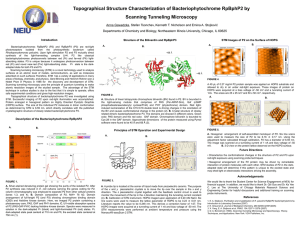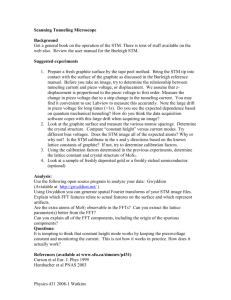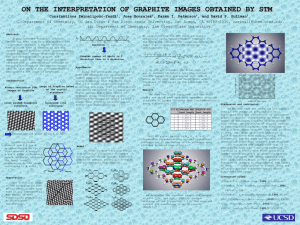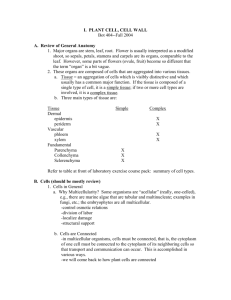Studies of gold clusters in graphite pits via scanning tunneling... Ulai Noomnarm, Asoka Kumar, Ivan Kravchenko, Liz Seiberling
advertisement
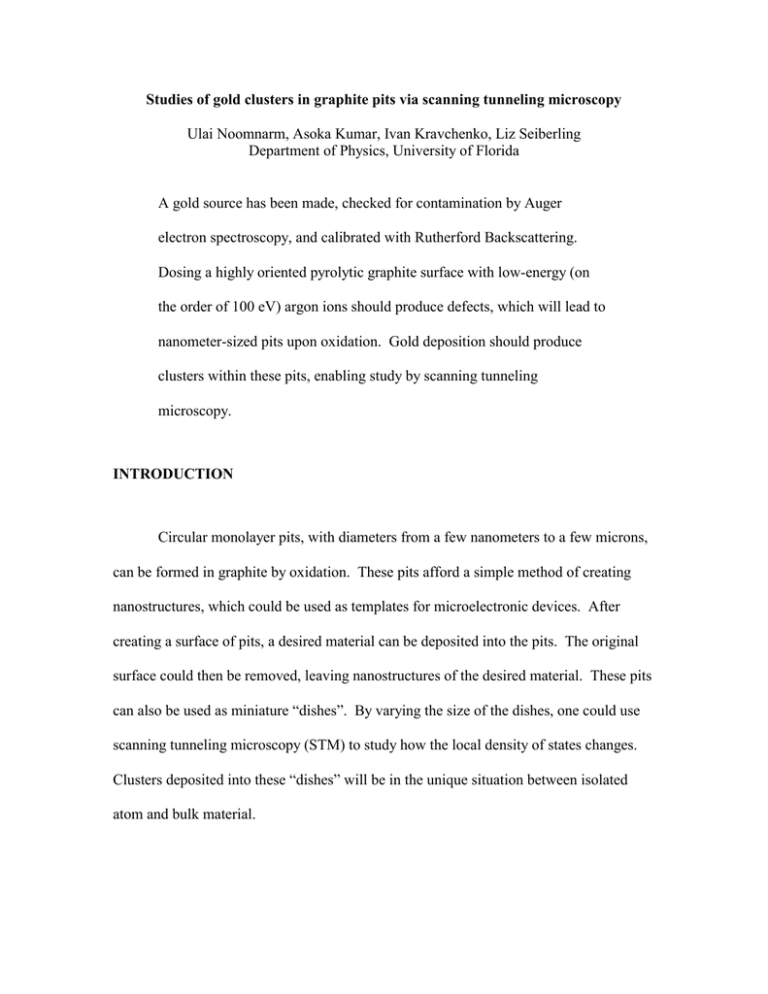
Studies of gold clusters in graphite pits via scanning tunneling microscopy Ulai Noomnarm, Asoka Kumar, Ivan Kravchenko, Liz Seiberling Department of Physics, University of Florida A gold source has been made, checked for contamination by Auger electron spectroscopy, and calibrated with Rutherford Backscattering. Dosing a highly oriented pyrolytic graphite surface with low-energy (on the order of 100 eV) argon ions should produce defects, which will lead to nanometer-sized pits upon oxidation. Gold deposition should produce clusters within these pits, enabling study by scanning tunneling microscopy. INTRODUCTION Circular monolayer pits, with diameters from a few nanometers to a few microns, can be formed in graphite by oxidation. These pits afford a simple method of creating nanostructures, which could be used as templates for microelectronic devices. After creating a surface of pits, a desired material can be deposited into the pits. The original surface could then be removed, leaving nanostructures of the desired material. These pits can also be used as miniature “dishes”. By varying the size of the dishes, one could use scanning tunneling microscopy (STM) to study how the local density of states changes. Clusters deposited into these “dishes” will be in the unique situation between isolated atom and bulk material. The purpose of this project is to create nanometer-sized pits that are one monolayer deep on highly oriented pyrolytic graphite (HOPG). These pits will be used as holding centers for gold clusters to study their interaction and properties via a STM. BACKGROUND Graphite Pits HOPG consists of parallel layers of atoms arranged in a hexagonal honeycomb pattern. Since the covalent bonds between atoms within a layer are much stronger than the weak van der Waals forces between the graphite layers, cleaving the sample exposes a clean surface. This is done by applying adhesive tape to the HOPG sample and slowly peeling the tape off, which removes one layer of the sample. Heating this fresh HOPG at temperatures below 700 ºC in molecular oxygen forms circular monolayer pits of uniform size at naturally occurring defects on the graphite [1]. Adjusting the temperature T, duration t, and oxygen partial pressure pO2 during oxidation controls the pit diameter d, given by the formula d = C exp(-Ea/RT)pO2t where R is the gas constant, Ea = 1.27×105 J mol-1 is the activation energy for monolayer etching with O2, and for pit densities above 15 pit µm-2 C = 4×104 nm mbar-1 s-1[2]. For example, with T = 530 ºC, pO2 = 213 mbar, t = 20 min., the pit diameter should be approximately 6 nm. STM The STM is based on quantum mechanical tunneling, with the small space that separates the sample from the tip serving as a barrier that classically keeps electrons from traveling between the tip and the sample [3]. When a small voltage exists between the sample and the tip at close enough distances, the electrons move from one surface to another with a tunneling current I given by I ∝ e-2κd where κ is the decay constant, and d is the separation between the tip and the sample. Because of the sensitivity of this tunneling current to the separation, a map of the sample’s local density of states can be obtained with atomic resolution, if the tip size is sufficiently small. Piezoelectric crystals, whose size changes with voltage, control the position of the sample relative to the tip and move the tip across the surface during the scan. The strong dependence of the tunneling current on separation makes vibration isolation a necessity. Suspending the sample stage and the STM itself by springs isolates vibration, as does magnetic eddy current dampening. Auger Auger Electron Spectroscopy (AES) provides a surface-sensitive measure of the composition of a surface [4]. The emission of Auger electrons is a radiationless process. An electron gun produces a “hole” in a core energy level, which is filled by an electron from a higher energy level (Fig. 1). Emission of a secondary electron with an energy corresponding to the difference between the two energy levels deexcites the system. The system is now doubly ionized by radiationless emission of an Auger electron with energy characteristic of the element from which it came. Rutherford Backscattering (RBS) RBS occurs when a beam of incident particles is scattered elastically from a sample surface at angles greater than 90° [5]. The scattered particles’ energy depends on the masses of the particles and the target. This dependence provides an identification of the elements in the target sample, since the mass of the incident particles is known. As the incident particles travel more deeply into the sample, they lose energy. This energy loss provides an absolute depth measurement of the elements in the sample. EXPERIMENT Before preparing the pits, we made a gold source which we then calibrated using AES to check for contaminants coming from the source and RBS to determine the source’s deposition rate. The graphite pit density formed by heating alone is insufficient to ensure finding small pits within the STM scan area. At low pit densities, the gold may also deposit on larger defect sites rather than in the small pits. To induce higher pit densities, we plan to damage the graphite surface with low-energy argon ions prior to heating. These ions generate defects on the HOPG, which turn into monolayer deep pits upon oxidation [6]. We will then heat the graphite sample, deposit gold, and examine with the STM. Gold source preparation Because we used a homemade gold source, we first made a small vacuum chamber in which to test the gold source without contaminating the existing ultrahigh vacuum (UHV) chamber. The test chamber has ports to a turbo pump, an ion gauge, the gold source, a sample, and a window through which we can see the sample. After baking to remove contaminants from the chamber, our lowest pressure was 1×10-7 mbar. The gold source consists of a tungsten filament attached to a copper feedthrough. The filament’s end tapers to form a basket holding the gold pieces. A tantalum guide attaches to the feedthough, surrounding the filament, which focuses the gold deposition to a smaller area. We first deposit the gold on a glass sample, which enables us to monitor the deposition visually. After depositing for 15 min at a current of 5.82 A the gold source produces a visible film on the glass sample. Upon obtaining a definite deposition current that did not destroy the source, we transferred the gold source to the existing UHV chamber. In this chamber, we can perform Auger analysis, ion dosing, and eventually STM without breaking the vacuum (approximately 10-10 mbar). A deposition rate that produces visible films after only 15 min is too high to create sub-monolayer coverage on HOPG. Therefore, we deposited gold at lower currents on a silicon sample in timed intervals. After each deposition interval, we used AES to determine whether gold had deposited. AES also showed us any contaminants that may have come from the gold source, which is important since we need a pure source to study the gold clusters. The most likely contaminants are carbon and oxygen, with peaks at 271 eV and 503 eV, respectively. As seen in Fig. 2, the intensity of the silicon peak at 92 eV decreases while that of the gold peak at 69 eV increases with deposition time and a current of 4.05 A. Once the gold peak intensity reached a level nearly comparable to that of the silicon peak, we performed RBS on the sample to determine the absolute thickness of the gold film. One can calculate the film thickness by the formula Nt = A/( σ Ω Q) where A is the area of the gold peak, σ is the scattering cross section of gold (5.2496×10-24 cm2/str for a 2.5 MeV incident He beam), Ω is the solid angle of the detector (0.00187 str), and Q is the total charge of the beam. For 1 hr deposition at a current of 4.05 A, Q = 3.72496×10-6 µC, resulting in a thickness of 1.7×1015atoms/cm2, or approximately 2.43 monolayers. Figure 3 shows the RBS spectrum for this sample. The peak on the left is gold and the step, characteristic of a substrate, is for silicon. Thus for a 10 min deposition at 4.05 A, we should obtain a sub-monolayer coverage. Argon ion irradiation To increase the pit density, we plan to damage a freshly-cleaved HOPG surface with argon ions. These ions should have energies on the order of 100 eV, which will produce vacancy defects that generate small pits upon oxidation [6]. For a submonolayer surface damaging of 1011 to 1013 ions/cm2 at 20 s of ion dosing, the sample current should be 8×10-10 to 8×10-8 A/cm2. While testing the ion gun, we had difficulties measuring the sample current because of a poor contact between the sample holder on the manipulator and the sample heater, which held the actual sample. After removing the sample holder from the manipulator, we designed and fabricated a new sample holder, and attached it to the manipulator in the UHV vacuum chamber. This sample holder is made entirely of molybdenum, in contrast to the previous one, which contained stainless steel parts. Molybdenum’s low vapor pressure at high temperatures is important for maintaining a low pressure in the UHV chamber during sample heating. Since we heat a sample by passing a current through the sample holder, it is necessary to have a good contact. The new sample holder met this requirement. Pit Formation We will heat the HOPG to 560 °C for 10 min. At this temperature, oxidation should still occur but at a slower rate than the more typical 600 °C. We will repeat this process both before and after ion dosing for comparison. STM We will use the STM to examine the oxidized HOPG after gold deposition to examine the interaction and properties of the gold clusters. When the STM returned from the manufacturer’s repair work, it came with the original sample holder rather than the sample holder used by this lab. Since our samples do not fit the original sample holder, we have modified the sample holder sent back with the STM to work with our samples. CONCLUSION We have prepared a gold source. By examining the deposition with AES we determined that only negligible amounts of carbon and gold came from the gold source. We then analyzed the gold deposition with RBS to determine that the absolute thickness of the gold coverage was sufficient for sub-monolayer coverage. We have also designed and fabricated sample holders for the STM and the UHV chamber manipulator. Further work could include actually making the pits on ion-damaged HOPG, depositing with gold, and examining by STM, if necessary. One could also study the effects of using different argon ion energies or different types of ions on the resultant pits. Using different ion doses should change the pit density, allowing studies over a wider range of pit separations. ACKNOWLEDGEMENTS Thanks to Liz Seiberling for her guidance and support, Ivan Kravchenko for obtaining the RBS results and teaching me about pit formation, and Asoka Kumar for teaching me about UHV practices, AES, STM and lab work in general. Thanks also to Kevin Ingersent and Alan Dorsey for organizing this program and the National Science Foundation for financial support. REFERENCES [1] H. Chang and A. J. Bard, J. Am. Chem. Soc. 112, 4598-4599 (1990); 113, 5588-5596 (1991). [2] H. Hövel, T. Becker, A. Bettac, B. Reihl, M. Tschuddy, and E. J. Williams, J. Appl. Phys. 81, 154-158 (1997). [3] C. J. Chen, Introduction to Scanning Tunneling Microscopy (Oxford University, New York, 1993). [4] H. Lüth, Surfaces and Interfaces of Solid (Springer-Verlag, New York, 1993). [5] W. Chu, Backscattering Spectrometry (Academic Press, New York, 1978). [6] J. R. Hahn and H. Kang, J. Vac. Sci. Technol. A 17, 1606-1609 (1999). M M1 L3 L2 L1 K Figure 1. Auger electron emission. A u on S i(100) at 4.05 A 60 m in Si Au 40 m in 25 m in dN /dE (A rbitrary U nits) 15 m in 5 m in C lean C lea n S i(100 ) 100 50 100 200 300 400 150 K inetic E nergy (eV ) Figure 2. Auger spectra of Au deposited on Si at a current of 4.05 A. 500 600 200 A u on S i(100) at 4.05 A 1500 1000 C ounts Si 500 Au 0 0 200 400 600 C hannel Figure 3. RBS spectra of Au deposited on Si at 4.05 A for 1 hr. with 2.5 MeV incident He beam for 10 min. and a total charge of 3.72496×10-6 µC.

